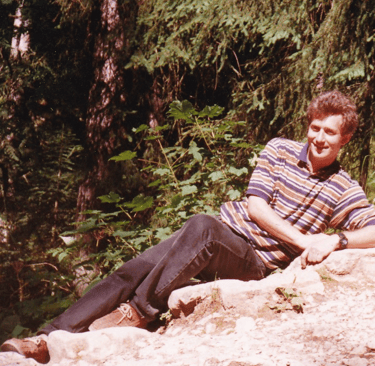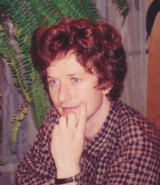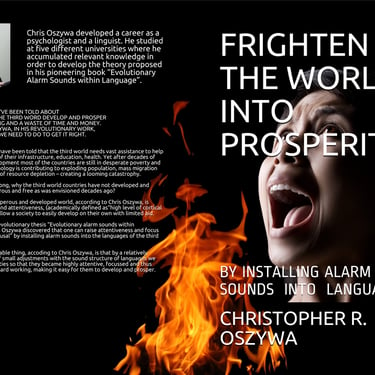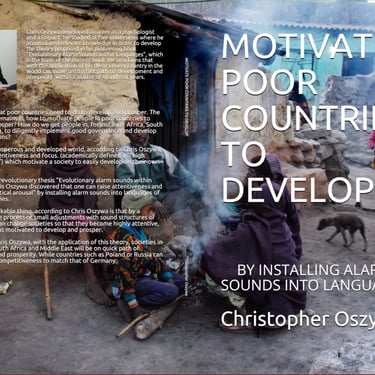
Author of Evolutionary Alarm Sounds within Languages
Christopher Richard Oszywa - Krzysztof Ryszard Oszywa
"I was always a curious and analytical person. This curiosity led me to observe the link between sounds in languages, specifically 'alarm sounds,' and the differences in cortical arousal among societies. More specifically, the more prevalent and intense these sounds are in a language, the greater the sustained focus and sense of urgency in that society.
Over time, this idea expanded and developed into a comprehensive theory that incorporated linguistic, biological, evolutionary, psychological, historical, and economic aspects. This theory became quite a significant journey in my life."
By Christopher Richard Oszywa
Image of Chris Oszywa as a young boy. "I had a curious and sensitive nature, however I was quite sickly"
Hi, my name is Christopher Richard Oszywa, and I am the pioneer or creator of the theory of “Evolutionary Alarm Sounds within Languages.”
I was born in the Holy Cross mountains in Poland. My parents were both academics; my mum was a language teacher and conducted linguistic research at a university in Kraków, while my dad was a horticulturist and a teacher. When I was 11 years old, my parents migrated to Sydney, Australia, via Vienna, Austria, due to Martial Law in Poland, which was part of the Solidarity revolution attempting to overthrow the Communist system.
As a teenager in Australia, I attended multicultural schools where I was keen on sports and biology. Around the age of 17 or 18, I first recognized the importance of Alarm Sounds in languages. “I remember walking between different levels of a TAFE building when I realized that there must be something significant about the sounds in languages that causes such differences among students from various countries or cultures.” I specifically compared two friends, Carlos from South America, who was very relaxed and social, and Winston from Hong Kong, who was more intense and focused.
Around this time, I had a strange experience, almost supernatural. Being a person who believes in science, I didn't think much of it then. I believe during sleep, a light from the stars shone into my eyes as if transferring information, with letters reminiscent of Egyptian hieroglyphs, gold in color. This phenomenon lasted for a few hours over several nights. One night, I sleepwalked to the living room, pointing at a large window towards the sky, and the glass shattered into little pieces. My dad witnessed this and said he'd never seen anything like it.
This cognition regarding sounds in languages propelled me on a lifelong journey to discover the idea of Evolutionary Alarm Sounds within Languages. Naturally, I preferred to study Commerce and Finance, but I decided to pursue psychology and linguistics, which was initially a weakness for me, to research this topic. (Remember how I used to stay up until 4 am, drinking coffee and smoking cigarettes to stimulate myself to continue this investigation? Remember how I would go to different libraries to search deep in storage for articles from the 1950s, 60s, and 70s on this topic? This took many years of work.)
This culminated in the publishing of my book, “Evolutionary Alarm Sounds within Languages,” and subsequent improved editions with more marketable titles like “Frightened the World into Prosperity” and “Motivate Poor Countries to Develop."
I hold a formal degree with a double major in Linguistics and Psychology, and I have completed postgraduate studies leading to my registration as a Psychologist. I practiced professionally in a private clinic for 15 years
Overview of the Book “Evolutionary Alarm Sounds within Languages”:
Chapter One: Describes the evolutionary basis of alarm sounds and how they occur in languages, noting that developed or rapidly developing societies speak languages with a high concentration of these sounds.
Chapters Two and Three: Outline major languages and illustrate that industrious and highly developed societies speak languages with intense and frequent alarm sounds.
Chapter Four: Explores the theory in a historical context, showing how past civilizations used alarm sounds in their languages to drive development and organization.
Chapter Five: Examines the psychological impact of alarm sounds on human and animal behavior, discussing how these sounds affect early brain structure and automatic responses.
Chapter Six: Discusses how the effects of alarm sounds, including high focus and a sense of urgency, might be advantageous for economic development, touching on Wundt's curve and optimal performance, as well as possible aggression sounds in Arabic and Korean.
Final Note:
Unlike many other hypotheses on the economic development of poor countries, this theory is actually applicable and testable. We can engineer a language to contain more alarm sounds with higher intensity, observe how the population becomes more focused with a higher sense of urgency, and see how this leads to a more organized, efficient, and prosperous society.
Christopher Richard Oszywa




Image of Chris Oszywa at about the age of 18, "I had my first intuition into the idea that later become the theory of alarm sounds"
Image of Chris Oszywa Traveling in Tatra mountains, in Poland. "I was already deeply preocupied with the theory of Evolutionary Alarm Sounds within Languages"


Image of Chris Oszywa in late 20's "I am at Grandmas place, where I spent 2 weeks, putting together the first manuscript of the theory"










